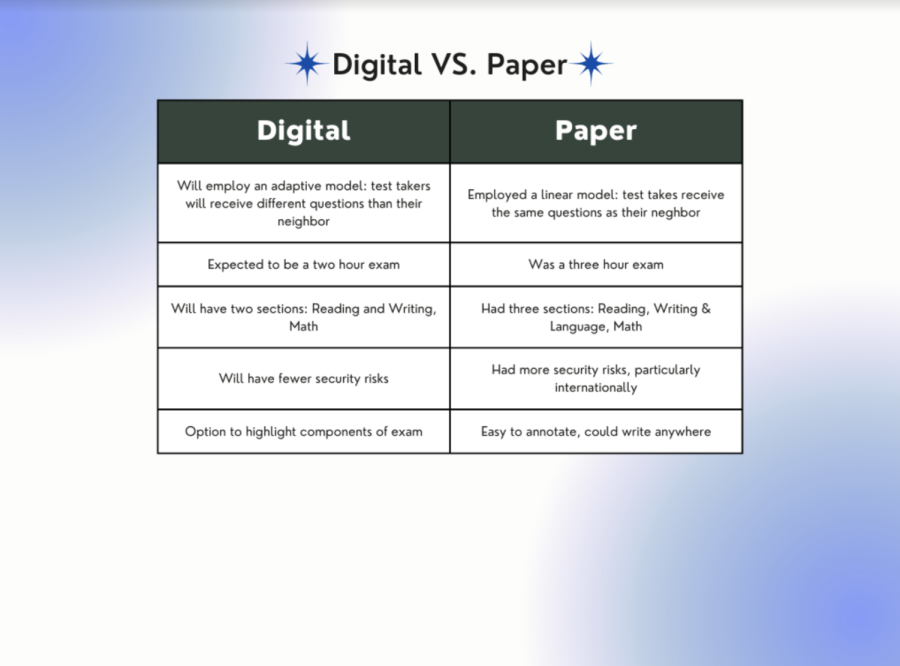SAT Revamped, Transitioning To Online, Shorter Test
February 14, 2023
In early 2022, the College Board announced that the SAT would transition to an online format for domestic testing beginning in spring 2024.
The digital SAT will utilize the multistage adaptive testing (MST) model, different from the linear model of the pencil and paper exam. Each section of the exam will be divided into two modules, those being an introductory module and a second module. The test taker’s performance in the introductory module will dictate the difficulty of the second module.
The digital exam in itself will also be shorter, as it is expected to span over the course of around two hours rather than three. The adaptive model makes it so that a student’s achievement level can be more easily understood in a smaller sample of questions. Test takers will have to download the testing application that the exam will be present on prior to arrival at their respective testing center. With this downloaded, students will no longer have to bubble in needed information, which will also accelerate the speed of the exam.
English teacher Dr. John Peruggia, who has tutored students for the SAT in past years, is not a fan of the adaptive style and favors the current model, emphasizing the unfair importance of starting the exam in a strong manner.
“It becomes really important that you do well early and maintain that,” Dr. Peruggia said. “For kids who maybe warm up as they’re taking the tests, adaptive testing is very tricky because you’re setting yourself off at a lower starting point. You’re always at the bottom.”
A major difference of the digital SAT is that it will be taken in two sections rather than three. The digital version will combine the Reading and Writing & Language sections to make a singular Reading and Writing section, which will be accompanied by the Math section. Additionally, there will be a difference in the content for the digital exam, which the College Board refers to as “more direct” questions.
“In the Reading and Writing section, instead of a few long reading passages with multiple questions per passage, students will see many shorter texts, each tied to just one question,” the College Board wrote on their Digital FAQ website. “For the Math section, questions in context (word problems) will be more concise than those on the current test.”
Given these major differences in the exam, Dr. Peruggia expects the style of SAT tutoring to change drastically.
“I think SAT tutors are going to be more forced now to actually teach content rather than tricks because there’s gonna be fewer tricks based on the kinds of questions if it’s more content based,” he said.
According to the College Board, it will take only a few days for scores to be returned to test takers, much faster than the current 13 days it takes. Dr. Peruggia notes that this can help tutoring in that students know what they have to work on much more quickly if they plan to retake it.
The change from pencil and paper to computer screen has an impact beyond the test and its format in itself. It has other implications, including security.
Director of College Counseling Mrs. Anna Wright finds the increased security of a digital exam rather helpful, particularly for international exams. When she lived in London, she witnessed this potential security issue first hand. The College Board sent the exams in a lockbox with a padlock, and she did not receive the lock combination until the morning of the exam.
“There have been all kinds of issues of proctors helping students, proctors giving kids extra time, kids getting access to the test questions,” Mrs. Wright said. “If you offer it digitally, you really eliminate almost all of those issues.”
Additionally, moving to a digital exam makes note taking more difficult. Although scratch paper will be allowed and the exam software will have an ability to annotate on it, many, like senior Darian Salehi, find it easier to have paper on their desk.
“Going digital is not as good because it’s much harder to annotate a passage,” Salehi said. “I prefer writing, and I can write or underline wherever with the exam in front of me.”
The SAT and standardized testing is becoming less prevalent in college admissions decisions, particularly since the COVID-19 pandemic broke out in 2020. Mrs. Wright projects that universities will stay test-optional for the next few years to evaluate how much they would like to consider the digital SAT in their admissions decisions.
“COVID taught us the testing was not as essential as we thought it was five years ago,” she said. “It taught admissions officers that they can make good decisions without testing. It takes years for universities to evaluate how they consider stuff, and I think that universities will be totally flexible for the next couple of years until they see.”
The College Board will release more information pertaining to the timing of the exam, number of questions, scoring information, and more during the coming summer. After being taken on paper for 98 straight years, the SAT’s change to a digital exam is a landmark modification in standardized testing.



